Effects of Microbial Fertilizer Combined with Organic Fertilizer on Forage Productivity and Soil Ecological Functions in Grasslands of the Muli Mining Area
Abstract
1. Introduction
2. Results
2.1. Effects of Combined Microbial Inoculant and Organic Fertilizer Application on Artificial Grassland Biomass
2.2. Effects of Combined Application of Microbial Inoculants and Organic Fertilizers on Forage Nutritional Quality in Artificial Grassland
2.3. Effects of Combined Application of Microbial Inoculants and Organic Fertilizers on the Physical and Chemical Properties of Artificial Grassland Soil
2.4. Effects of Combined Microbial Inoculant and Organic Fertilizer Application on Soil Enzyme Activities in Artificial Grassland
2.5. Effects of Combined Microbial Inoculant and Organic Fertilizer Application on Soil Microbial Biomass Carbon, Nitrogen, and Phosphorus in Artificial Grassland
2.6. Correlation Analysis of Forage Yield Quality, Soil Physicochemical Properties, and Soil Enzyme Activities Under Different Fertilization Treatments
2.7. Path Analysis of Soil Physicochemical Properties, Microbial Biomass, Soil Enzyme Activities and Forage Yield Quality
2.8. Comprehensive Evaluation of Soil Physicochemical Properties, Microbial Biomass, Soil Enzyme Activities, and Forage Yield Quality Characteristics
3. Discussion
3.1. Effects of Combined EM Microbial Inoculant and Organic Fertilizer Application on Productivity and Nutritional Quality of Artificial Grasslands
3.2. Effects of EM Microbial Inoculant and Organic Fertilizer Co-Application on Soil Physicochemical Properties, Enzyme Activities, and Microbial Biomass
3.3. Correlation Analysis and Comprehensive Evaluation of Forage Productivity, Nutritional Quality, and Soil Biochemical Properties
3.4. Cost-Effectiveness and Practical Feasibility
4. Materials and Methods
4.1. General Situation of the Study Area
4.2. Experimental Materials
4.3. Experimental Design
4.4. Plant and Soil Sampling
4.5. Measurements and Methods
4.6. Data Analysis and Visualization
5. Conclusions and Prospects
5.1. Conclusions
5.2. Prospects
Author Contributions
Funding
Data Availability Statement
Conflicts of Interest
References
- Liu, J.R.; Zhao, C.X.; Li, C.N.; Lei, L.J.; Ta, F.; Lai, S.W.; Feng, Y.L.; Zhou, Z.P.; Jin, M. Mixed planting mode is the best measure to restore soil quality in alpine mines. Soil Tillage Res. 2024, 244, 106209. [Google Scholar] [CrossRef]
- Lyu, L.Y.; Liu, Q.Q.; He, M.H.; Gao, P.; Cai, Z.C.; Shi, J.J. Screening Suitable Ecological Grasses and the Seeding Rate in the Muli Mining Area. Sustainability 2024, 16, 10184. [Google Scholar] [CrossRef]
- Meng, S.J.; Wang, P.; Yin, W.P.; He, B.T.; Li, P.; Xue, Y. Spatial and Temporal Patterns and Drivers of Grassland NEP in the Muri Region, 2000 to 2022. Air Soil Water Res. 2024, 17, 11786221241271557. [Google Scholar] [CrossRef]
- Zhu, X.Z.; Lan, J.M.; Huang, F.C.; Wang, D.; Dai, L.L.; Chen, C.; Xiang, L.; Wu, W.B. Multidimensional Effects of Revegetation on Antimony Mine Waste Slag: From Geochemical Responses to Ecological Risk Regulation. Appl. Sci. 2025, 15, 7587. [Google Scholar] [CrossRef]
- Bi, Y.L.; Tian, L.X.; Du, X.P.; Yin, K.J. Optimizing soil pore structure in mined land: Integrating arbuscular mycorrhizal fungi and mixed planting for ecological restoration. Plant Soil 2025, 1–18. [Google Scholar] [CrossRef]
- Zhang, W.; Hou, M.B.; Wu, S.Y.; Chen, S.; Wang, X.M. Manure-derived dissolved organic matter enhanced colloid-facilitated transport of Cd in arable soil in the vicinity of a mining area. J. Soils Sediments 2025, 25, 2228–2239. [Google Scholar] [CrossRef]
- Yue, X.; Gong, J.Y.; Zhang, L.Y.; Zhang, M.H.; Chen, J.; Liang, H.; Chen, Y.H.; Fu, X.H.; Su, R.K.; Luo, Y.T. Research Progress of Mine Ecological Restoration Technology. Resources 2025, 14, 100. [Google Scholar] [CrossRef]
- Yu, Z.Y.; Yao, X.X.; Yang, M.C.; Hu, S.B.; An, X.T.; Li, C.H. Co-application of sheep manure and commercial organic fertilizer enhances plant productivity and soil quality in alpine mining areas. Front. Microbiol. 2024, 15, 1488121. [Google Scholar] [CrossRef]
- Wen, Y.J.; Liu, X.; Yang, N.; Li, Y.P.; Zhang, J.C. The Contribution of Microbial- and Plant-Derived Carbon to Soil Organic Carbon Fractions and Stability Under Manure Application Combined with Straw Incorporation. Agronomy 2025, 15, 1424. [Google Scholar] [CrossRef]
- Sun, X.C.; Zhao, L.J.; Li, Y.L.; Chen, W.; Zhao, Y.; Yan, A.; Wan, J.C. Effects of additives on the fermentation and microbial quantity of legume-grass mixtures silage. Pratacult. Sci. 2025, 42, 1313–1329. [Google Scholar] [CrossRef]
- Tu, Y.C. The Study of Compound Microbial Bacterial Fertilizer in Soil Improvement on Drought Mining Area; China University of Mining and Technology: Xuzhou, China, 2015. [Google Scholar]
- Yan, X.; Wang, J.L.; Hu, X.W.; Yu, B.B.; Gao, B.W.; Li, Z.L.; Chen, J.H.; Zhang, M.J.; Liu, X.Y. Contrasting effects of microbial fertiliser and organic fertiliser on soil bacterial community in coal mine dump of Inner Mongolia. Chem. Ecol. 2021, 37, 384–398. [Google Scholar] [CrossRef]
- Yuan, Q.; Sun, C.F.; Li, H.; Zhang, Q.; Gao, C.H. Effects of microbial fertilizers on soil organic carbon of reclaimed minesoils in aluminum mining wasteland. Soils 2013, 45, 419–425. [Google Scholar] [CrossRef]
- Dang, W. The Screening of Potassim Bacteria and Its Effects to Soil Fertility of Mine Area Reclaimation; Shanxi University: Taiyuan, China, 2015. [Google Scholar]
- Zhang, Y.X.; Bi, Y.L.; Shen, H.H.; Zhang, L.J. Arbuscular mycorrhizal fungi enhance sea buckthorn growth in coal mining subsidence areas in northwest China. J. Microbiol. Biotechnol. 2020, 30, 848–855. [Google Scholar] [CrossRef]
- Yin, N.N.; Zhang, Z.; Wang, L.P.; Qian, K.M. Variations in organic carbon, aggregation, and enzyme activities of gangue-fly ash-reconstructed soils with sludge and arbuscular mycorrhizal fungi during 6-year reclamation. Environ. Sci. Pollut. Res. 2016, 23, 17840–17849. [Google Scholar] [CrossRef]
- Ren, Z.R.; Shao, X.Q.; Li, J.S.; Li, H.; He, Y.X.; Gu, W.N.; Wang, R.Y.; Yang, L.J.; Liu, K.S. Effects of microbial fertilizers on aboveground biomass and soil physicochemical properties in degraded alpine meadows. Acta Agrestia Sin. 2025, 29, 2265–2273. [Google Scholar] [CrossRef]
- Gao, P.; Li, X.L.; Chai, Y.; Li, C.Y.; Li, X.H.; Wang, Y.; Zhao, X.Y.; Miao, J.H. Impacts of microbial inoculants combined with sheep manure on community characteristics and soil fungal diversity in degraded grasslands of the Three-River Source Region. China Environ. Sci. 2025, 1–18. [Google Scholar] [CrossRef]
- Kumawat, A.; Kumar, D.; Shivay, Y.S.; Sangwan, S.; Yadav, D.; Pooniya, V.; Ali, S.; Madhu, M.; Rashmi, I.; Bhargavi, B.; et al. Exploring optimal combinations of green manures, composts, and microbial inoculums to boost soil biological properties, nutrient release, and Basmati rice yield. Int. J. Plant Prod. 2025, 19, 99–116. [Google Scholar] [CrossRef]
- Wen, Y.F.; Ma, Y.M.; Wu, Z.N.; Yang, Y.G.; Yuan, X.J.; Chen, K.R.; Luo, Y.H.; He, Z.T.; Huang, X.H.; Deng, P.X.; et al. Enhancing rice ecological production: Synergistic effects of wheat-straw decomposition and microbial agents on soil health and yield. Front. Plant Sci. 2024, 15, 1368184. [Google Scholar] [CrossRef]
- Song, X.C.; Liu, M.Q.; Wu, D.; Griffiths, B.S.; Jiao, J.G.; Li, H.X.; Hu, F. Interaction matters: Synergy between vermicompost and PGPR agents improves soil quality, crop quality and crop yield in the field. Appl. Soil. Ecol. 2015, 89, 25–34. [Google Scholar] [CrossRef]
- Da, C.L.; Li, Y.J.; Hu, R.M.; Yu, X.J.; Xu, C.L.; Shi, Z.C.; Xu, J.J. Effects of different fertilization treatments on vegetation community characteristics and nutritional value of degraded alpine meadows. Grassl. Turf 2025, 45, 83–90. [Google Scholar] [CrossRef]
- Montañez, R.L.; Calero, E.; Quispe, K.; Huasasquiche, L.; Lastra, S.; La Torre, B.; Solórzano, R. Synergy between microbial inoculants and mineral fertilization to enhance the yield and nutritional quality of maize on the Peruvian coast. Appl. Microbiol. 2024, 4, 1757–1775. [Google Scholar] [CrossRef]
- Akladious, S.A.; Abbas, S.M. Application of Trichoderma harzianum T22 as a biofertilizer potential in maize growth. J. Plant Nutr. 2014, 37, 30–49. [Google Scholar] [CrossRef]
- Duan, L.X.; Ju, Z.L.; Ma, X.; Pan, J.; Mustafa, A.E.Z.M.A.; Jia, Z.F. Research on enhancing the yield and quality of oat forage: Optimization of nitrogen and organic fertilizer management strategies. Agronomy 2024, 14, 1406. [Google Scholar] [CrossRef]
- Zhang, F.L.; Wang, N.; Zhao, C.Y.; Yang, L.Z.; Zhao, X.M.; Gao, H.J.; Zhang, F.G.; Wang, H.B.; Huang, N. Enhancing black soil fertility and microbial community structure via microbial agents to reduce chemical fertilizer dependency: A strategy to boost maize yield. Agronomy 2025, 15, 1029. [Google Scholar] [CrossRef]
- Mbuthia, L.W.; Acosta-Martínez, V.; de Bruyn, J.; Schaeffer, S.; Tyler, D.; Odoi, E.; Mpheshea, M.; Walker, F.; Eash, N. Long term tillage, cover crop, and fertilization effects on microbial community structure, activity: Implications for soil quality. Soil Biol. Biochem. 2015, 89, 24–34. [Google Scholar] [CrossRef]
- Lin, L.; Zhang, D.G.; Cao, G.M.; Ouyang, J.Z.; Liu, S.L.; Zhang, F.W.; Li, Y.K.; Guo, X.W. Soil nutrient variation at using microbial fertilizer on alpine meadow in Qing-Tibet Plateau. Grassl. Turf 2015, 35, 12–16. [Google Scholar] [CrossRef]
- Wang, J.Y.; Qin, H.L.; Zhang, L.Y.; Tang, Y.F.; Long, J.J.; Xu, H.Q.; Zhu, B.L. Synergistic effects of rhizosphere effect and combined organic and chemical fertilizers application on soil bacterial diversity and community structure in oilseed rape cultivation. Front. Microbiol. 2024, 15, 1374199. [Google Scholar] [CrossRef]
- Shi, Y.L.; Li, T.T.; Zheng, L.; Jing, X.K.; Hussain, A.H.; Zhang, Q.W. Enhancing soil multifunctionality through restoring erosion environment and microbial functions combined with organic manure and straw mulching. Agric. Ecosyst. Environ. 2025, 383, 109515. [Google Scholar] [CrossRef]
- Zhi, L.Y.; Zheng, B.X.; Xu, Y.J.; Xu, J.Y.; Peñuelas, J.; Sardans, J.; Chang, Y.X.; Jin, S.Q.; Ying, H.; Ding, K. Organic fertilizers shape the bacterial communities harboring pqqC and phoD genes by altering organic acids, leading to improved phosphorus utilization. Soil Ecol. Lett. 2025, 7, 250296. [Google Scholar] [CrossRef]
- Basak, B.B.; Jat, R.S.; Gajbhiye, N.A.; Saha, A.; Manivel, P. Organic nutrient management through manures, microbes and biodynamic preparation improves yield and quality of Kalmegh (Andrograghis paniculata), and soil properties. J. Plant Nutr. 2020, 43, 548–562. [Google Scholar] [CrossRef]
- Jia, R.; Zhou, J.; Yang, L.; Blagodatskaya, E.; Jones, D.L.; Razavi, B.S.; Yang, Y.D.; Kuzyakov, Y.; Zeng, Z.H.; Zang, H.D. Trade-off between soil enzyme activities and hotspots area depends on long-term fertilization: In situ field zymography. Sci. Total Environ. 2024, 954, 176386. [Google Scholar] [CrossRef] [PubMed]
- Deng, L.; Wang, T.; Luo, W.; He, L.Y.; Liang, Z.S. Effects of a compound microbial agent and plants on soil properties, enzyme activities, and bacterial composition of Pisha sandstone. Environ. Sci. Pollut. Res. 2021, 28, 53353–53364. [Google Scholar] [CrossRef]
- Ren, S.Y.; Liu, Y.H.; Liu, Y.H.; Xu, M.W. Effects of microbial compound inoculants on plant growth and soil quality in degraded grasslands. Acta Ecol. Sin. 2025, 45, 3240–3251. [Google Scholar] [CrossRef]
- Maciejewska, K.; Lemanowicz, J.; Jaskulska, I. Effects of Long-Term Multi-Treatment Experiments on Organic Matter and Enzymatic Activity in Sandy Soil. Sustainability 2025, 17, 3252. [Google Scholar] [CrossRef]
- Chen, D.M.; Zang, L.P.; Zhang, G.Q.; Liu, Q.F.; Sui, M.Z.; Liu, Y.R. Organic-inorganic fertilization optimizes phoD-harboring microbial communities and increases phosphorus availability in paddy soils under intensive rice cropping. Appl. Soil Ecol. 2025, 211, 106129. [Google Scholar] [CrossRef]
- Chen, X.D.; Wang, Y.; Guo, B.; Liu, J.L.; Qiu, G.Y.; Kuzyakov, Y.; Li, H. Long-term green manuring increases phosphorus availability in soil by modifying microbial functional genes and enzyme activities. Appl. Soil Ecol. 2025, 213, 106284. [Google Scholar] [CrossRef]
- Zhou, Z.R.; Liao, Y.; Zhang, Q.; Xiong, Z.C.; Tang, J.W.; Tian, J.; Chang, X.L.; Zhang, H.L.; Xiang, J.Y.; Lin, Z.Y.; et al. Insights into soil carbon metabolism and carbon sequestration capacity under organic fertilizer substitution model. Appl. Soil Ecol. 2025, 213, 106235. [Google Scholar] [CrossRef]
- Ren, F.L.; Sun, N.; Xu, M.; Zhang, X.B.; Wu, L.H.; Xu, M.G. Changes in soil microbial biomass with manure application in cropping systems: A meta-analysis. Soil Tillage Res. 2019, 194, 104291. [Google Scholar] [CrossRef]
- Su, X.T.; Li, Y.J.; Han, Y.C.; Sun, Z.P.; Da, C.L. Effects of chemical fertilizers and microbial fertilizer on soil nutrients and soil microbial biomass in degraded alpine meadow. Grassl. Turf 2025, 1–12. Available online: https://link.cnki.net/urlid/62.1156.S.20240521.1346.004 (accessed on 30 July 2025).
- Yin, Q.J.; Jiang, J.W.; Yin, H.Q.; Yang, Z.K.; Gong, D.Q.; Li, G.F.; Chu, X.Y.; Liu, W.B.; Zhang, M. Effects of organic inputs on soil nutrients and microbial metabolism in newly reclaimed farmlands. J. Appl. Ecol. 2025, 36, 969–983. [Google Scholar] [CrossRef]
- Yang, Y.H.; Li, M.J.; Wu, J.C.; Pan, X.Y.; Gao, C.M.; Tang, D.W.S. Impact of combining long-term subsoiling and organic fertilizer on soil microbial biomass carbon and nitrogen, soil enzyme activity, and water use of winter wheat. Front. Plant Sci. 2022, 12, 788651. [Google Scholar] [CrossRef] [PubMed]
- Jing, Y.D.; Liu, X.W.; Liang, K.; Feng, J.H.; Yu, Q.; Guo, L. Impacts of shrub encroachment on soil carbon fractions and stability of grassland on the Loess Plateau, and the underlying microbial mechanisms. Acta Pratacult. Sin. 2025, 34, 1–15. Available online: https://link.cnki.net/urlid/62.1105.S.20250710.1104.002 (accessed on 31 July 2025).
- Ma, X.H.; Huang, J.Y.; Yu, H.L.; Li, C.H.; Wang, X.Y. Soil organic carbon characteristics and their region under acid deposition. Acta Ecol. Sin. 2025, 45, 1–15. [Google Scholar] [CrossRef]
- Hu, Y.; Li, Y.; Liu, K.M.; Shi, C.Q.; Wang, W.; Yang, Z.G.; Xu, K.F.; Li, S.; Wang, Y.X.; Jin, L.; et al. Improving the stability of black soil microbial communities through long-term application of biochar to optimize the characteristics of DOM components. Biochar 2025, 7, 84. [Google Scholar] [CrossRef]
- Song, C.X.; Cao, L.; Li, G.H. Current status of research and application of effective microorganisms (EM) in agriculture. J. Anhui Agric. Sci. 2022, 50, 21–23+54. [Google Scholar] [CrossRef]
- GB 20287–2006; General Standard for Microbial Fertilizers. Standards Press of China: Beijing, China, 2006.
- NY/T 525–2021; Organic Fertilizer. Ministry of Agriculture and Rural Affairs of the People’s Republic of China: Beijing, China, 2021.
- GB 6141–2008; Method for Particle Size Distribution Test of Seeds. Standards Press of China: Beijing, China, 2008.
- Dyer, A.R.; Eviner, V.T.; Malmstrom, C.M.; Rice, K.J. Living on leftovers: Biomass management in annual grasslands may shift functional group dominance. Arid. Land Res. Manag. 2025, 39, 409–427. [Google Scholar] [CrossRef]
- Cai, Z.C.; Shi, J.J.; Lv, L.L.; Gao, P.; Zhang, H.R.; Li, F.Y.; Fu, S.Q.; Liu, Q.Q.; Bao, S.C. Construction of a Green and Sustainable Cultivation Model for Annual Forage Oat in Alpine Ecosystems: Optimization and Synergistic Mechanisms of Combined Application of Microbial Fertilizers and Organic Fertilizers. Plants 2025, 14, 1271. [Google Scholar] [CrossRef]
- Bao, S.D. Soil Agrochemical Analysis, 3rd ed.; China Agricultural Press: Beijing, China, 1999. [Google Scholar]
- Jiang, S.C.; Du, B.; Hu, F.Q.; Zhang, H.W.; Kong, P.; Wu, Q.X.; Zhu, J.Q. A seven-year study on the effects of four tillage modes on soil physicochemical properties, microbial biomass, enzymatic activities, and grain yield in a rice-ratoon rice cropping system. Food Energy Secur. 2023, 12, e437. [Google Scholar] [CrossRef]
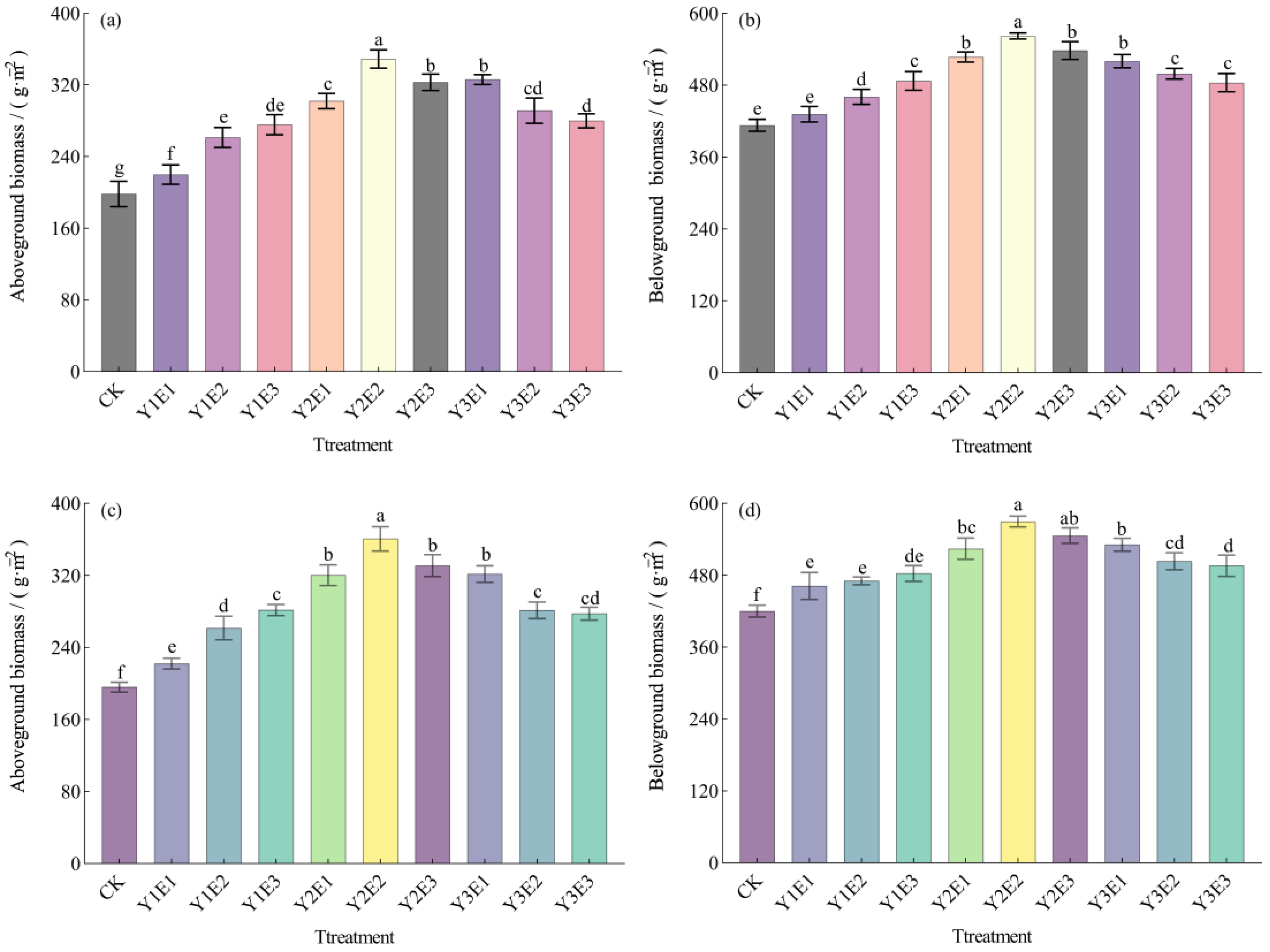
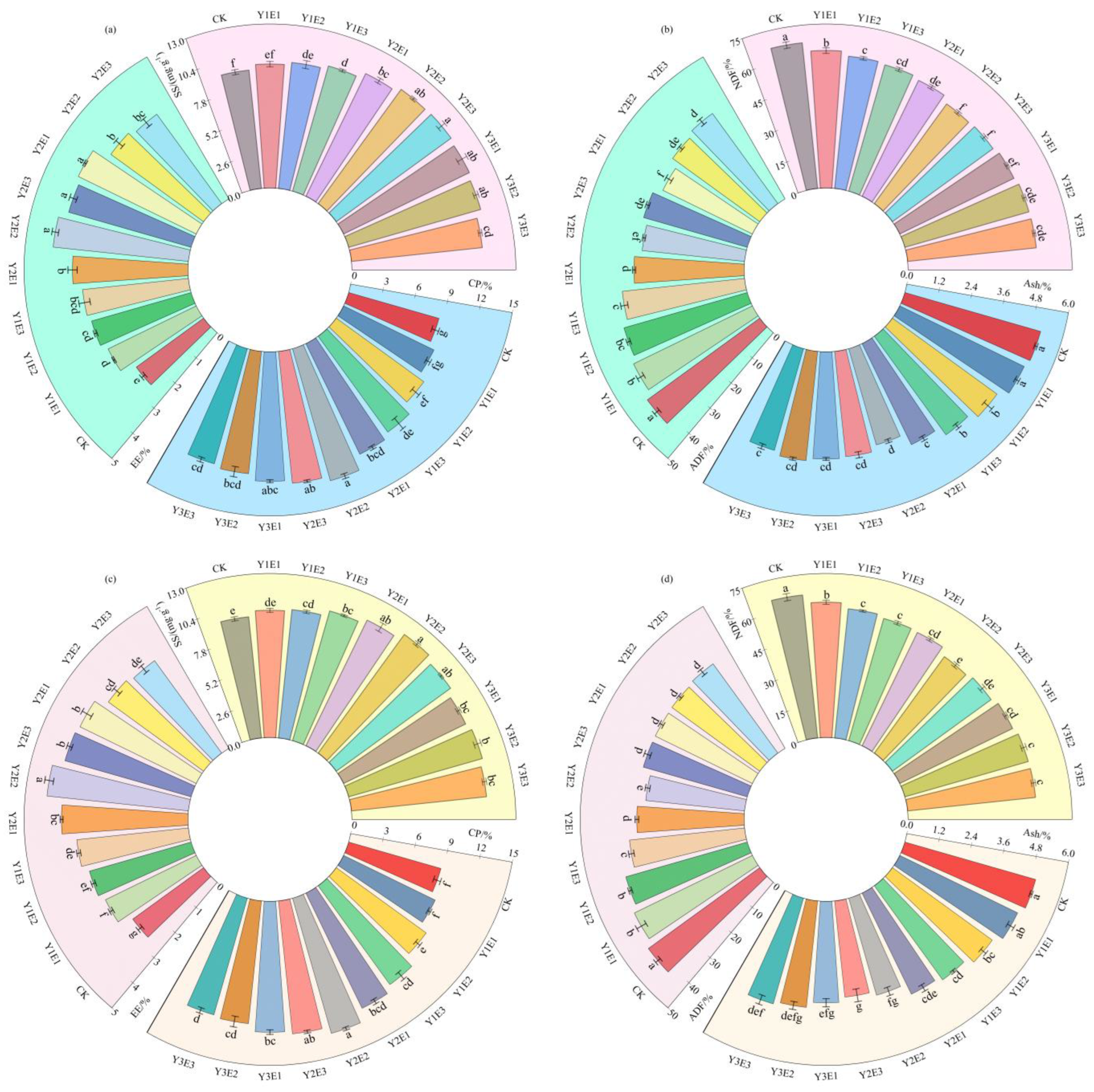
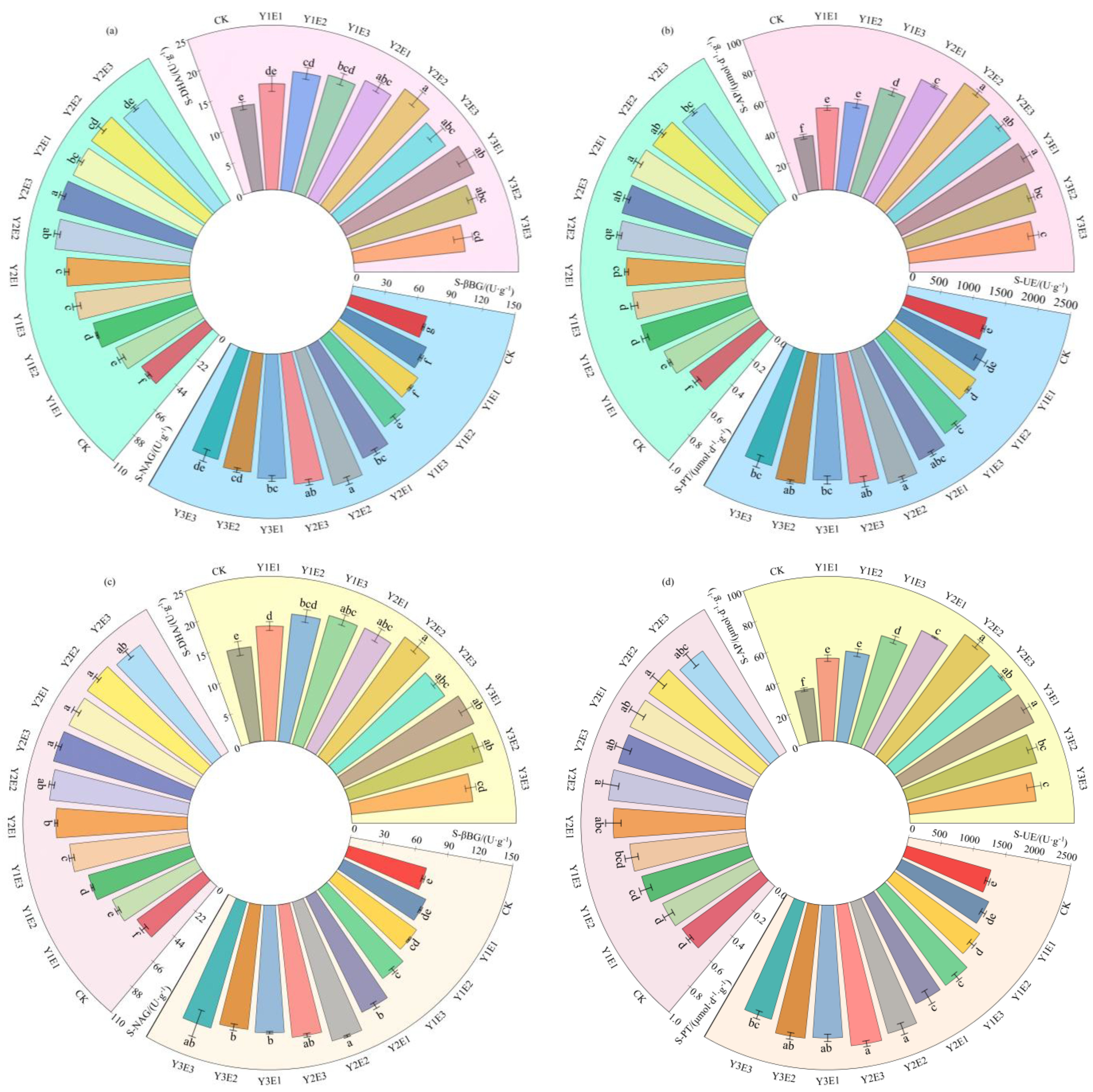
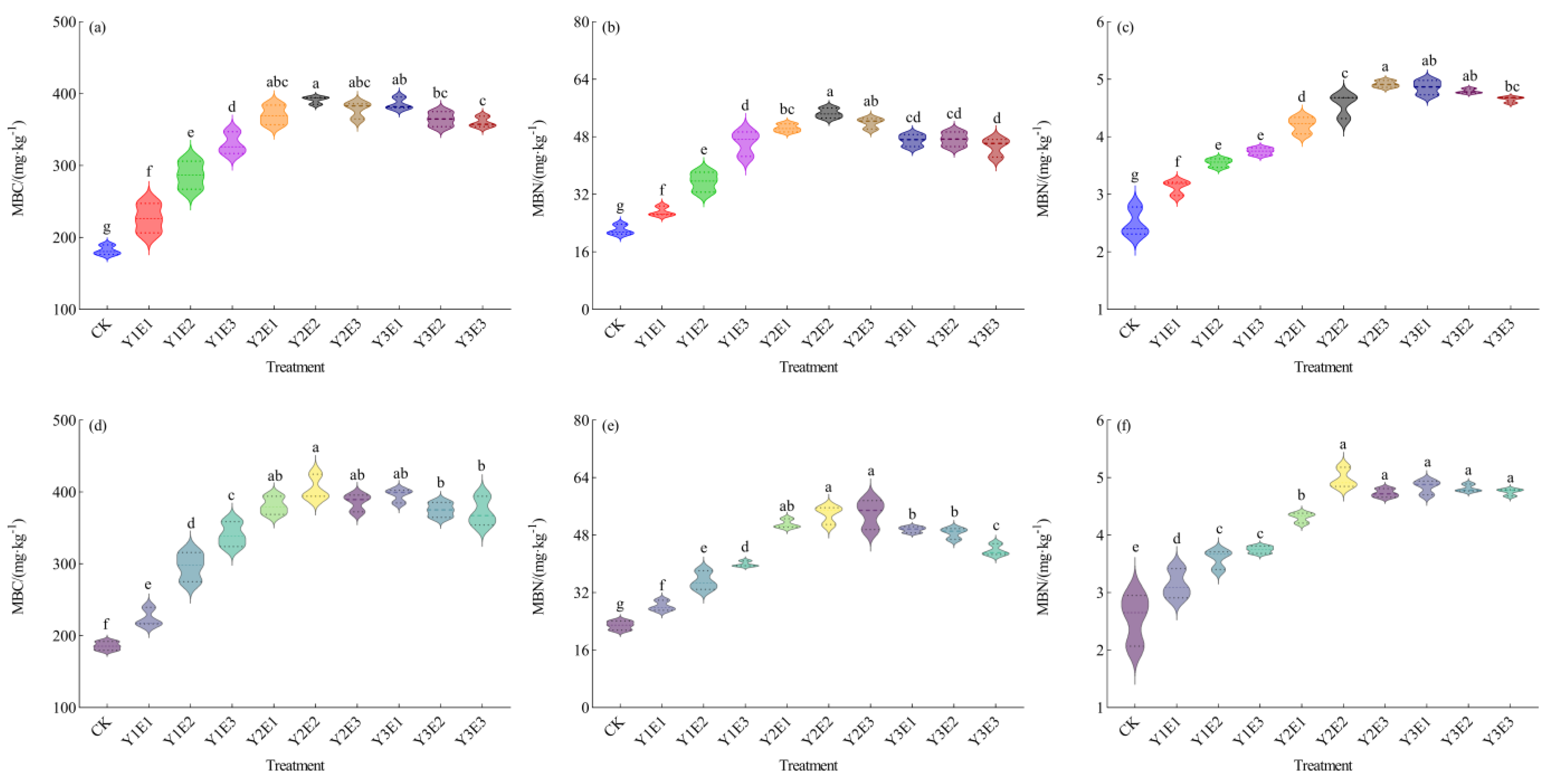
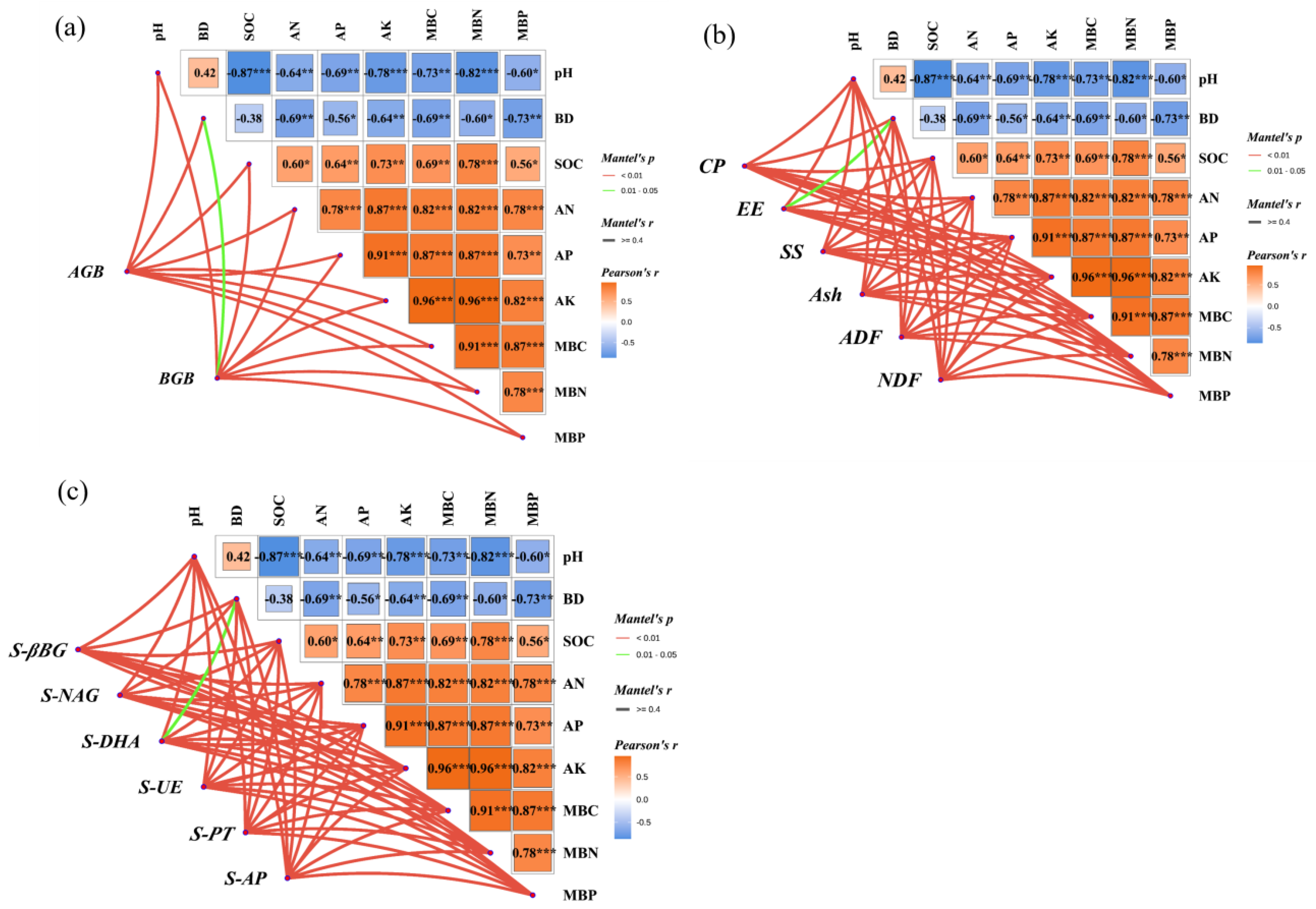
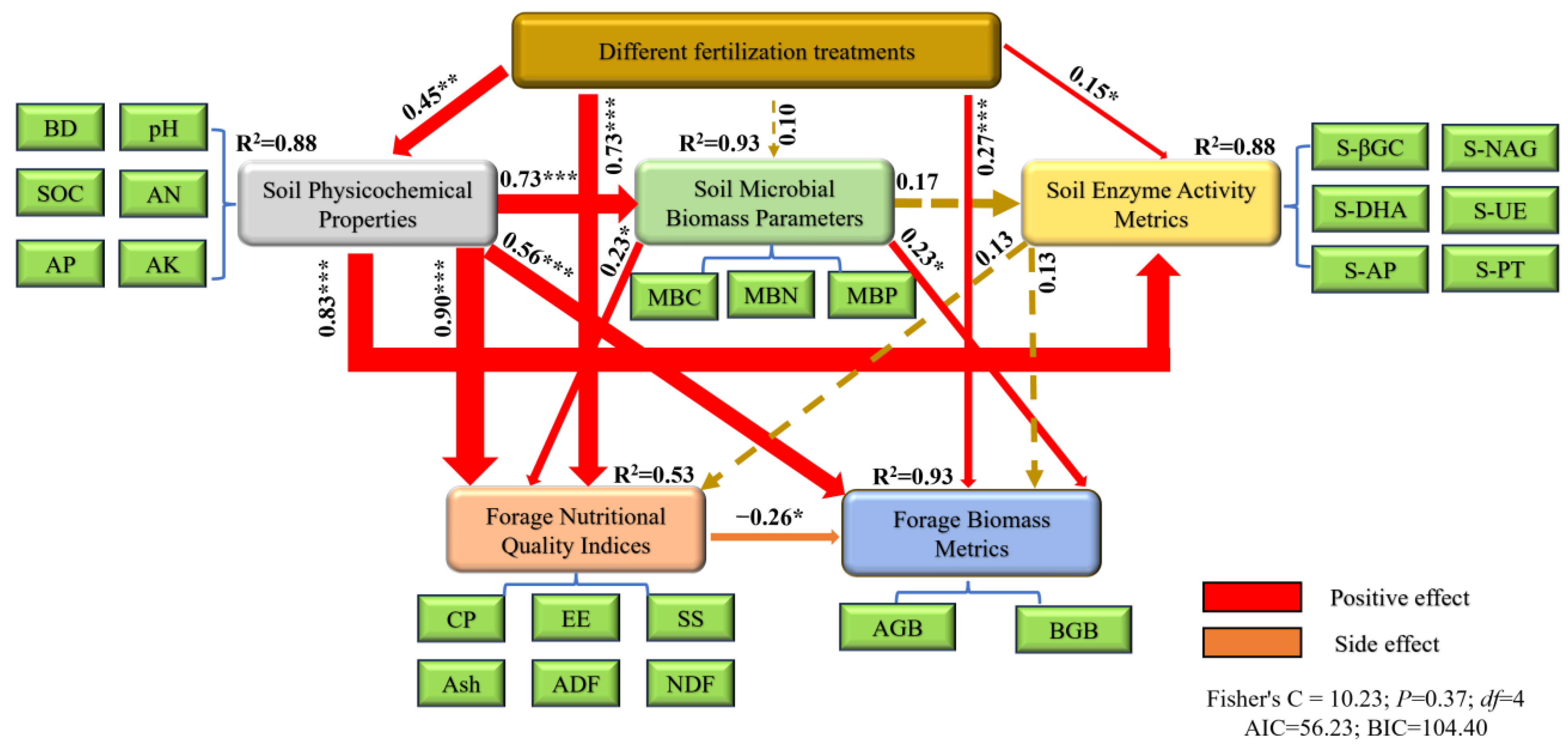

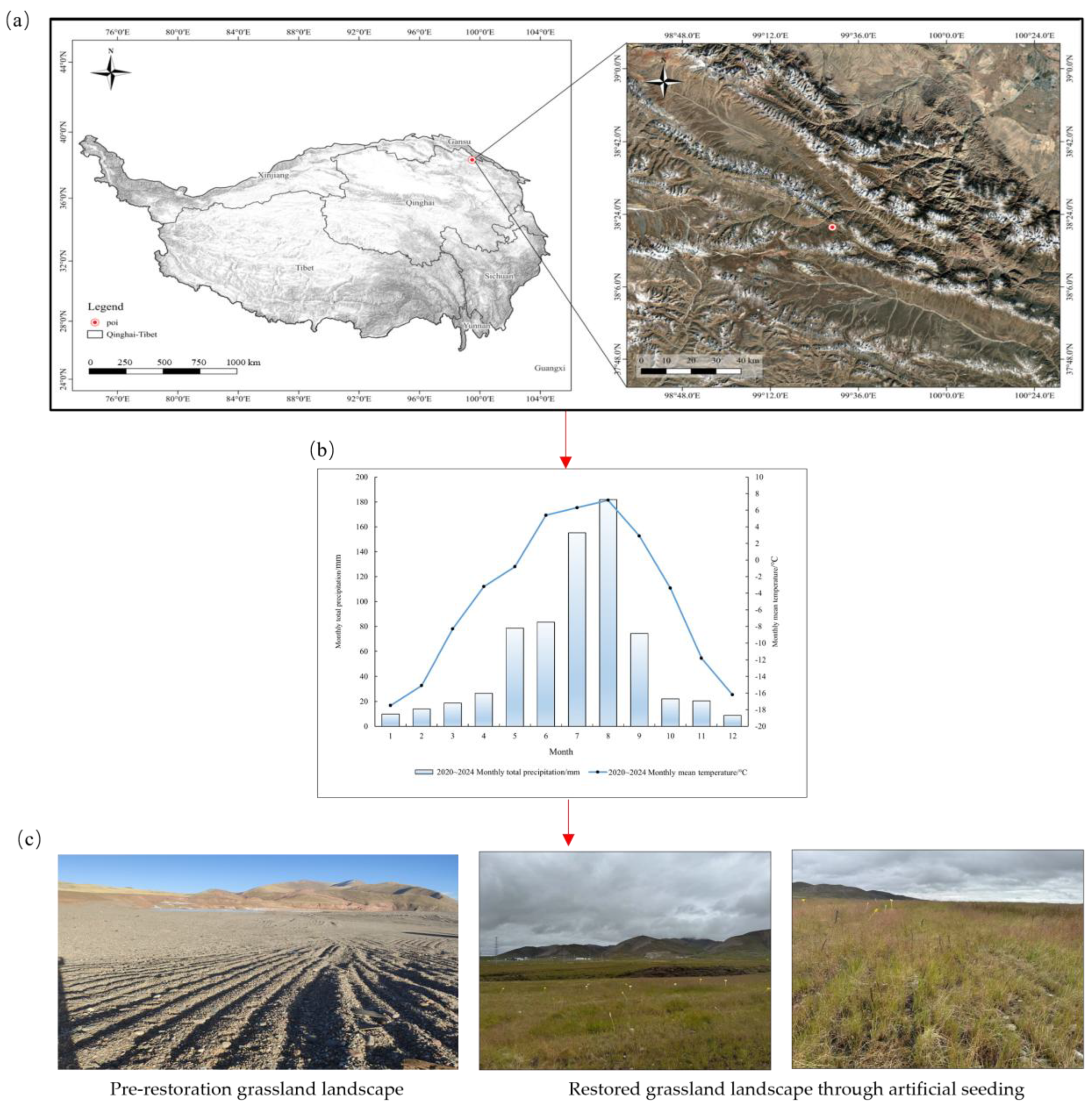
| Treatment | pH | BD/(g·cm−1) | SOC/(g·kg−1) | AN/(mg·kg−1) | AP/(mg·kg−1) | AK/(mg·kg−1) |
|---|---|---|---|---|---|---|
| CK | 8.78 ± 0.04 a | 1.74 ± 0.03 a | 84.99 ± 3.56 g | 171.66 ± 2.41 f | 19.70 ± 0.34 f | 238.72 ± 2.98 h |
| Y1E1 | 8.62 ± 0.04 b | 1.70 ± 0.01 a | 109.23 ± 3.51 f | 194.12 ± 1.9 e | 24.01 ± 0.87 e | 270.09 ± 2.32 g |
| Y1E2 | 8.50 ± 0.03 c | 1.47 ± 0.04 b | 126.68 ± 1.34 de | 212.99 ± 3.52 d | 29.92 ± 1.13 d | 297.25 ± 17.6 f |
| Y1E3 | 8.40 ± 0.04 d | 1.18 ± 0.07 c | 131.64 ± 1.76 cd | 228.10 ± 4.9 c | 30.62 ± 0.31 cd | 361.57 ± 19.64 e |
| Y2E1 | 8.30 ± 0.04 e | 1.13 ± 0.08 c | 139.66 ± 1.10 ab | 234.85 ± 2.44 bc | 33.57 ± 0.67 bc | 456.10 ± 10.11 bc |
| Y2E2 | 8.05 ± 0.03 g | 1.08 ± 0.09 cd | 146.80 ± 3.45 a | 259.18 ± 2.08 a | 37.47 ± 1.28 a | 470.01 ± 1.86 a |
| Y2E3 | 8.20 ± 0.02 f | 1.17 ± 0.13 c | 138.63 ± 2.49 bc | 252.68 ± 2.02 a | 39.23 ± 0.29 a | 461.60 ± 23.84 ab |
| Y3E1 | 8.30 ± 0.02 e | 1.02 ± 0.06 cd | 131.80 ± 2.71 bcd | 236.34 ± 7.7 bc | 36.38 ± 1.57 ab | 453.61 ± 9.09 bc |
| Y3E2 | 8.41 ± 0.02 d | 0.93 ± 0.01 d | 125.17 ± 3.38 de | 239.64 ± 1.49 b | 36.98 ± 0.53 a | 432.37 ± 13.69 cd |
| Y3E3 | 8.38 ± 0.02 de | 1.05 ± 0.03 cd | 123.37 ± 2.05 e | 238.27 ± 1.10 bc | 35.97 ± 2.45 ab | 416.42 ± 32.75 d |
| Treatment | pH | BD/(g·cm−1) | SOC/(g·kg−1) | AN/(mg·kg−1) | AP/(mg·kg−1) | AK/(mg·kg−1) |
|---|---|---|---|---|---|---|
| CK | 8.82 ± 0.04 a | 1.64 ± 0.04 a | 78.60 ± 2.52 f | 180.01 ± 1.20 e | 20.94 ± 0.41 e | 247.81 ± 3.59 f |
| Y1E1 | 8.56 ± 0.06 b | 1.50 ± 0.06 ab | 116.40 ± 1.66 e | 203.16 ± 2.53 d | 24.35 ± 0.65 e | 279.71 ± 7.84 e |
| Y1E2 | 8.40 ± 0.06 c | 1.36 ± 0.07 b | 131.32 ± 3.20 d | 217.55 ± 1.12 d | 31.82 ± 1.14 d | 304.13 ± 16.62 e |
| Y1E3 | 8.30 ± 0.04 cd | 1.12 ± 0.05 c | 138.91 ± 4.00 cd | 237.45 ± 7.01 c | 32.89 ± 1.53 cd | 390.91 ± 7.64 d |
| Y2E1 | 8.20 ± 0.04 de | 1.06 ± 0.07 cd | 150.22 ± 5.64 ab | 240.68 ± 2.41 bc | 40.23 ± 1.10 ab | 462.10 ± 34.72 bc |
| Y2E2 | 7.84 ± 0.04 f | 1.03 ± 0.07 cde | 151.65 ± 2.94 a | 257.37 ± 11.79 ab | 41.73 ± 2.39 a | 485.91 ± 6.06 a |
| Y2E3 | 8.11 ± 0.04 e | 0.98 ± 0.08 cde | 144.45 ± 4.23 abc | 268.67 ± 4.91 a | 39.89 ± 0.74 ab | 470.29 ± 17.29 ab |
| Y3E1 | 8.17 ± 0.03 de | 1.06 ± 0.09 cde | 139.51 ± 5.12 bcd | 246.51 ± 6.68 bc | 38.29 ± 1.04 ab | 463.12 ± 12.77 bc |
| Y3E2 | 8.36 ± 0.06 c | 0.87 ± 0.02 e | 135.53 ± 3.21 cd | 248.16 ± 9.13 bc | 37.63 ± 1.16 b | 467.54 ± 35.64 abc |
| Y3E3 | 8.36 ± 0.03 c | 0.90 ± 0.05 de | 133.81 ± 3.11 cd | 244.7 ± 3.96 bc | 36.89 ± 2.24 bc | 427.17 ± 34.97 c |
| Treatment Group | Organic Fertilizer (t·hm−2) | Effective Microorganisms (t·hm−2) |
|---|---|---|
| CK | 10.00 | — |
| Y1E1 | 10.00 | 0.45 |
| Y1E2 | 10.00 | 0.60 |
| Y1E3 | 10.00 | 0.75 |
| Y2E1 | 20.00 | 0.45 |
| Y2E2 | 20.00 | 0.60 |
| Y2E3 | 20.00 | 0.75 |
| Y3E1 | 40.00 | 0.45 |
| Y3E2 | 40.00 | 0.60 |
| Y3E3 | 40.00 | 0.75 |
Disclaimer/Publisher’s Note: The statements, opinions and data contained in all publications are solely those of the individual author(s) and contributor(s) and not of MDPI and/or the editor(s). MDPI and/or the editor(s) disclaim responsibility for any injury to people or property resulting from any ideas, methods, instructions or products referred to in the content. |
© 2025 by the authors. Licensee MDPI, Basel, Switzerland. This article is an open access article distributed under the terms and conditions of the Creative Commons Attribution (CC BY) license (https://creativecommons.org/licenses/by/4.0/).
Share and Cite
Cai, Z.; Shi, J.; Fu, S.; Li, F.; Lv, L.; Liu, Q.; Zhang, H.; Bao, S. Effects of Microbial Fertilizer Combined with Organic Fertilizer on Forage Productivity and Soil Ecological Functions in Grasslands of the Muli Mining Area. Plants 2025, 14, 3156. https://doi.org/10.3390/plants14203156
Cai Z, Shi J, Fu S, Li F, Lv L, Liu Q, Zhang H, Bao S. Effects of Microbial Fertilizer Combined with Organic Fertilizer on Forage Productivity and Soil Ecological Functions in Grasslands of the Muli Mining Area. Plants. 2025; 14(20):3156. https://doi.org/10.3390/plants14203156
Chicago/Turabian StyleCai, Zongcheng, Jianjun Shi, Shouquan Fu, Fayi Li, Liangyu Lv, Qingqing Liu, Hairong Zhang, and Shancun Bao. 2025. "Effects of Microbial Fertilizer Combined with Organic Fertilizer on Forage Productivity and Soil Ecological Functions in Grasslands of the Muli Mining Area" Plants 14, no. 20: 3156. https://doi.org/10.3390/plants14203156
APA StyleCai, Z., Shi, J., Fu, S., Li, F., Lv, L., Liu, Q., Zhang, H., & Bao, S. (2025). Effects of Microbial Fertilizer Combined with Organic Fertilizer on Forage Productivity and Soil Ecological Functions in Grasslands of the Muli Mining Area. Plants, 14(20), 3156. https://doi.org/10.3390/plants14203156






